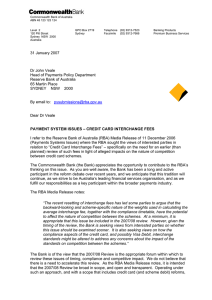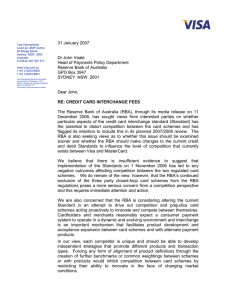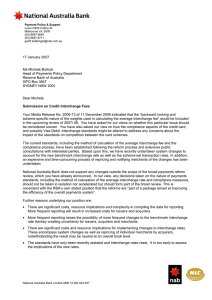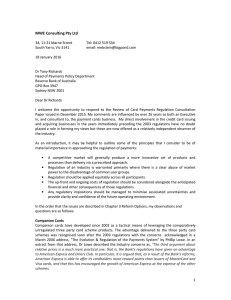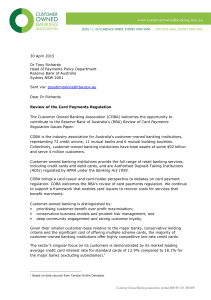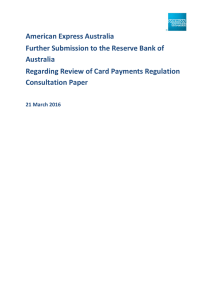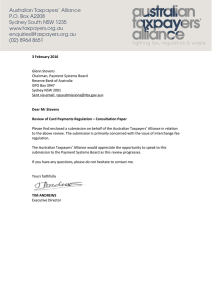MWE CONSULTING PTY LTD
advertisement
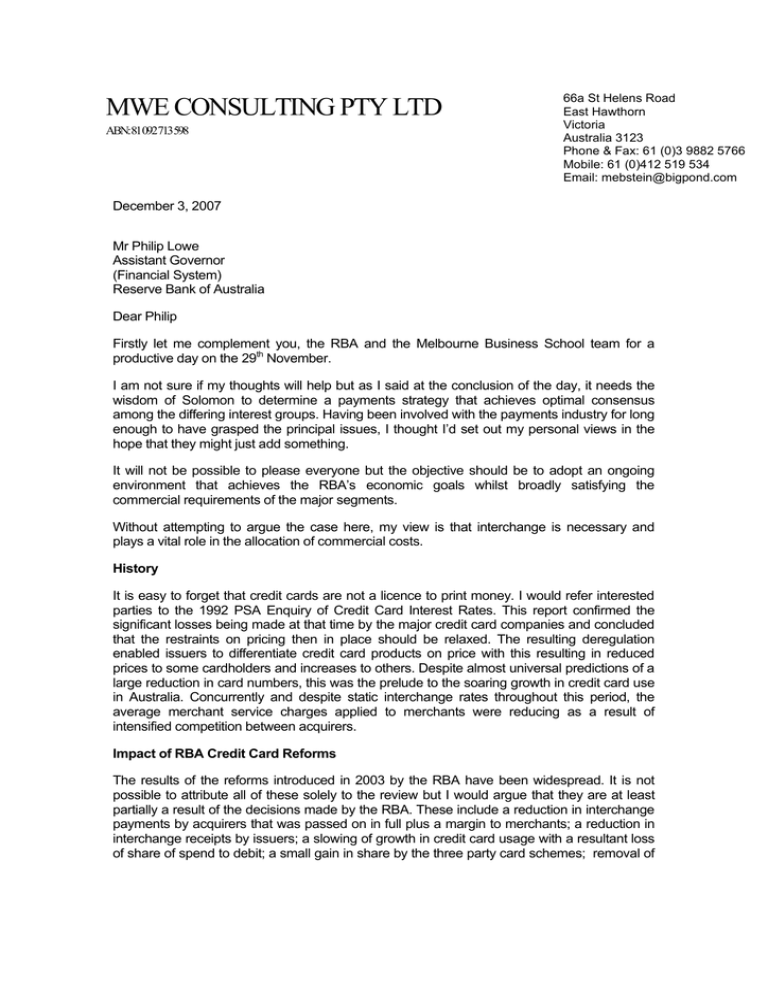
MWE CONSULTING PTY LTD ABN:81092713598 66a St Helens Road East Hawthorn Victoria Australia 3123 Phone & Fax: 61 (0)3 9882 5766 Mobile: 61 (0)412 519 534 Email: mebstein@bigpond.com December 3, 2007 Mr Philip Lowe Assistant Governor (Financial System) Reserve Bank of Australia Dear Philip Firstly let me complement you, the RBA and the Melbourne Business School team for a productive day on the 29th November. I am not sure if my thoughts will help but as I said at the conclusion of the day, it needs the wisdom of Solomon to determine a payments strategy that achieves optimal consensus among the differing interest groups. Having been involved with the payments industry for long enough to have grasped the principal issues, I thought I’d set out my personal views in the hope that they might just add something. It will not be possible to please everyone but the objective should be to adopt an ongoing environment that achieves the RBA’s economic goals whilst broadly satisfying the commercial requirements of the major segments. Without attempting to argue the case here, my view is that interchange is necessary and plays a vital role in the allocation of commercial costs. History It is easy to forget that credit cards are not a licence to print money. I would refer interested parties to the 1992 PSA Enquiry of Credit Card Interest Rates. This report confirmed the significant losses being made at that time by the major credit card companies and concluded that the restraints on pricing then in place should be relaxed. The resulting deregulation enabled issuers to differentiate credit card products on price with this resulting in reduced prices to some cardholders and increases to others. Despite almost universal predictions of a large reduction in card numbers, this was the prelude to the soaring growth in credit card use in Australia. Concurrently and despite static interchange rates throughout this period, the average merchant service charges applied to merchants were reducing as a result of intensified competition between acquirers. Impact of RBA Credit Card Reforms The results of the reforms introduced in 2003 by the RBA have been widespread. It is not possible to attribute all of these solely to the review but I would argue that they are at least partially a result of the decisions made by the RBA. These include a reduction in interchange payments by acquirers that was passed on in full plus a margin to merchants; a reduction in interchange receipts by issuers; a slowing of growth in credit card usage with a resultant loss of share of spend to debit; a small gain in share by the three party card schemes; removal of z Page 2 December 3, 2007 some barriers to entry (but with limited results to date); removal of the no-surcharge rule; removal of the honour-all-cards rule; increases in the cost of credit cards to cardholders; and a proliferation of interchange rates to achieve competitive and commercial objectives. The Issue The card schemes have traditionally been issuer centric. This is not surprising as their main focus is to grow cards on issue. To the extent that interchange revenue on one card product exceeds that available from competing products, an issuer will, other factors being equal, prefer one card scheme against another. This appears to me to be a reasonable commercial strategy, but with a significant caveat. To the extent that interchange is set to provide a commercial incentive to issuers, it will impact upon acquirers and merchants. I think there is evidence to indicate that the competitive nature of business banking and acquiring placed a ceiling on merchant service fees so that they were in fact declining in the years preceding the RBA review and were, by international standards, already at relatively low levels. Today, merchants have additional negotiating power through the removal of barriers to entry, the removal of the no-surcharge rule, and the removal of the honour-all-cards rule. The establishment of a common average interchange rate has removed the ability of the card schemes to use interchange as a competitive tool. To at least some extent, I believe that the proliferation of interchange rates within the overall market average is an attempt by the card schemes to continue to use this tool as a competitive feature. I suggest that in an ideal world, it would be preferable to maintain the ability of card schemes to differentiate their products via independently determined pricing strategies. To do so whilst protecting the interests of merchants is the key challenge. Philosophy My preference is to rely on market forces rather than centralised regulation in establishing market parameters. I did not agree that the situation preceding 2003 required intervention but the clock cannot be turned back. I would agree that the failure to amend interchange rates for many years prior to the RBA review was an industry shortcoming, although my recollection is that reviews were conducted but not acted upon as far as increases or decreases were concerned. I would suggest that the key role going forward is to ensure that a “set-and-forget” mentality is not resumed, with the overall industry therefore having the confidence of a rationally determined, cost related interchange rate. Recommendation The share of payments now on payment cards demonstrates the convenience, utility and security attributed to them by consumers. Despite substantial increases in credit card costs to cardholders and a reduction in the value of associated reward cards, the shift in cardholder behaviour has not been dramatic. The RBA has though achieved a substantial reduction in interchange rates as well as the removal of structural barriers and rules that have enhanced the negotiating powers of merchants. An alternative process could be a review that continues to be managed by the RBA but with the average interchange rate being a recommendation rather than a prescribed rate. This z Page 3 December 3, 2007 would deliver a publicly recognised rate whilst leaving the capacity to vary it with the schemes according to their individual strategies. The potential for the RBA to designate the rate would remain, with this acting as a moderating influence upon the extent to which the schemes would be likely to establish their own interchange rate with a differential to that recommended. A continuation of the amended access and surcharge rules in conjunction with a process that allows at least some discretion by the card schemes to determine interchange rates is in my opinion, a workable and preferable alternative to the present arrangement. Such a review provides the potential for the card schemes to use interchange as a competitive tool. I would argue that a scheme should maintain the right to use features such as brand, technology, distribution and acceptance as the basis for a lower or higher rate. It then remains for the scheme to attempt to market those features. If successful, they will achieve a higher return as a reward for superior features; if unsuccessful, they will lose share of issuers and / or merchant acceptance. But that is what innovation and market forces are all about. Yours sincerely, Michael Ebstein Director
